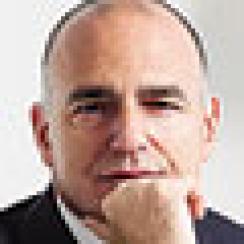What will the U.S. Federal Reserve Board do next? That question has been foremost on the minds of investors since May, when officials began hinting that the central bank might begin scaling back its $85 billion-a-month bond-purchase program as early as last month — provided the domestic economy was showing signs of sustainable growth. Would the tapering begin slowly, with a $10 billion- to $15 billion-a-month cutback, or would policymakers move more aggressively? The uncertainty has been keeping money managers on edge.
There’s no relief in sight given the surprise announcement after last month’s Federal Open Market Committee meeting that the bankers don’t plan to do anything — at least not yet.
“Many clients felt the message and rationale were not clear, especially since there had been so much talk from Fed officials about tapering,” reports Jonathan Rosenzweig, Citi’s New York–based head of Americas equity research. “Some investors expressed concern that the Fed knows something that others don’t about the state of the recovery or, at the other extreme, around the long-term inflation risks associated with an extended period of ultraloose policy.”
Brett Hodess, Rosenzweig’s crosstown counterpart at Bank of America Merrill Lynch, has heard similar complaints. “Many clients were upset by the Fed’s poor communication and expressed concerns about its credibility in guiding the markets,” he says.
Portfolio managers initially viewed the reprieve as a cause for celebration, sending the Dow Jones Industrial Average soaring more than 147 points to close at a record 15,676.94 that day. The euphoria didn’t last long, however, as investors contemplated the implications of the decision to maintain the status quo: the Fed’s belief that the U.S. economy still isn’t strong enough to stand on its own. Indeed, the policymakers slashed their forecasts for real gross domestic product growth for this year and next, resetting their low-end values from 2.3 percent to 2 percent for 2013 and from 3 percent to 2.9 percent for 2014.
| Related Content The All-America Research Team Hall of Fame October 7, 2013 The All-America Sales Team October 8, 2013 The All-America Trading Team October 8, 2013 America's Top Corporate Access Providers 2013 October 16, 2013 |
Further consideration of its stance prompted market participants to speculate anew as to when the Fed would begin cutting back on quantitative easing. Some think it could happen as early as this month; others, in December; and still others believe that the central bank won’t act until after January, to give chairman Ben Bernanke’s successor time to settle in to his or her new post.
| All-America Spotlight |



|



|


|
BofA Merrill rises from third place to second, but its modest climb belies the firm’s impressive gains; it picks up seven more positions, for a total of 41. Morgan Stanley also advances one rung, to No. 3, even though its team total is unchanged at 33. Barclays tumbles from second to fourth after losing eight spots, leaving it with 31. Deutsche Bank’s total also falls, from 32 to 28; nonetheless, it repeats in fifth place.
Citi is the biggest upward mover among the top firms, jumping from No. 8 to No. 6 after increasing its team total by three positions, to 26.
These results reflect the opinions of more then 3,300 investment professionals at nearly 990 firms that collectively oversee an estimated $10.5 trillion in U.S. equities. View the full 2013 All-America Research Team ranking.
Analyst reaction to last month’s announcement ranges from supportive to indifferent — even openly critical. “This is probably the biggest about-face from the Fed in the past decade,” observes François Trahan, who is No. 1 in Portfolio Strategy for a second straight year (and for the seventh time since 2005) and is also a runner-up in Quantitative Research. “They missed a great opportunity, since tapering was largely priced in.”
As for the bankers’ belief that the economic recovery is still too fragile, “they are wrong,” he declares. Policymakers are looking at lagging indicators — GDP growth and inflation rates, for example — when they should focus instead on such leading indicators as housing starts, inventory levels and manufacturing activity, he says.
Trahan, a founding partner of Cornerstone Macro, a New York–based research boutique that opened in April, points to data that support his position. Last month the National Association of Home Builders/Wells Fargo Housing-Market Index reached an eight-year high, he notes, while reports from the Tempe, Arizona–based Institute for Supply Management likewise showed the services sector growing at the fastest rate over the same period — and the manufacturing sector at the quickest pace in some 26 months.
“Consumer confidence is just shy of a five-year high,” he adds. “What else do they want?”
A more-promising labor market, for starters. The employment outlook “is far from what all of us would like to see,” Bernanke said at his press conference following the September meeting.
“They want more jobs? They’re about to get them,” Trahan insists. Figures from the National Federation of Independent Business, a Nashville, Tennessee–based organization that lobbies on behalf of small companies, “just popped higher, so jobs are about to rebound,” he contends.
The Fed’s decision to delay tapering only created confusion, the strategist maintains. “Utilities — a sector we do not like — rallied for two days, then went back to original trends,” Trahan says. “It was more noise than anything.”
Sectors he does recommend include consumer discretionary, owing to the ongoing low-inflation environment, and financial services, where growth is likely to remain robust thanks to the continuation of loose monetary policy.
Credit Suisse’s Howard Chen, who captures the top spot in Brokers, Asset Managers & Exchanges for a second consecutive year, agrees with the latter point but says money managers should buckle up because the ride will not be smooth.
“The renewed uncertainty should drive heightened market volatility over the near term,” the New York–based analyst predicts. Financial services stocks, which have outperformed the broad market over the past two years, will continue to do well, but investors must “stay disciplined, be more selective and bend to more of a quality bias to the exceptionally run companies within the sector.”
One of his preferred names is CME Group, largely on the strength of the Chicago-based exchange operator’s leading interest rate complex. “The stock should be a safe haven and provide good total return over the next few months,” Chen says.
Also recommended: New York–based alternative asset managers Apollo Global Management and Blackstone Group, and Carlyle Group of Washington. “We see strong secular, market and regulatory tailwinds driving exceptional growth; increasing earnings and dividend expectations as the better-managed firms progress through the value-creation and -harvesting cycles; and still highly attractive valuations,” he explains.
In addition, Goldman Sachs Group of New York and Boston’s State Street Corp. “are among the best positioned to participate in a better revenue backdrop given their discipline in controlling expenses and managing capital,” Chen says.
Consumers are also keeping a more careful watch on where their money is going — and the Fed’s concerns about economic growth may spur even more caution, according to J.P. Morgan’s Matthew Boss, who bolts from runner-up to claim his first appearance at No. 1 in Retailing/Broadlines & Department Stores and also scores a runner-up position in Apparel, Footwear & Textiles.
“While we believe the consumer remains resilient, we have seen a pullback in discretionary spending during nonevent — that is, nonholiday — periods, with innovation and newness separating the winners and losers,” says Boss, who works out of New York. “Importantly, back-to-school spending has illustrated an 80 percent correlation to holiday sales historically, which — when combined with a volatile spending backdrop and increased media coverage of the economic motivation behind the Fed’s recent decision — raises a level of concern heading into the holiday season.”
Last month the International Council of Shopping Centers, a New York–based trade association that tracks consumer spending, reported that same-store sales rose 3.6 percent year-over-year in August, far below the 6 percent increase during the same back-to-school shopping month in 2012.
“We continue to recommend ‘best-in-class’ companies with strong management teams and fortresslike balance sheets, which we believe is the best way to weather choppy waters through year-end,” he explains.
Dollar General Corp. of Goodlettsville, Tennessee, and Chesapeake, Virginia–based Dollar Tree “are the best ways to play the discount space today,” he contends, largely on the strength of their “easy compares”; that is, the companies shouldn’t experience much difficulty meeting or beating last year’s numbers.
Boss’s colleague John DiFucci, who zips from third place to land in the winner’s circle for the first time in Software, says his clients have reacted more positively to news of the QE extension. “The general conclusion is that this will continue to keep interest rates at historically low levels, which is good for equities,” he says. “Hence anyone that was somewhat concerned about potential negative, unforeseen perturbations in the market for the second half — especially given valuation levels — is less concerned now.”
That doesn’t mean the environment is viewed as worry-free. “We continue to wonder whether the federal government might dampen information technology spending,” he explains. “But most software companies seem to think things will be fine.”
Before the FOMC meeting, DiFucci predicted that two of three issues weighing on the market would subside in the second half, and he stands by that forecast. “We expect stability in IT spending in Europe after a difficult first half, and relative stability in financial services — perhaps even modest improvement given the market performance — because everyone feels better when the market goes up,” the New York–based researcher observes.
The third concern? A slowdown in government spending. “This could be exacerbated given that the September quarter is the federal government’s fiscal fourth quarter, which typically sees a seasonal uptick in spending, and the budget issues currently being discussed for the next fiscal year,” DiFucci explains.
He is bullish on Symantec Corp., a Mountain View, California–based developer of security software; and Islandia, New York’s CA Technologies, a provider of IT management solutions. “They still have attractive valuations, which lowers risk in this richly valued market,” he says.
Last month’s bombshell also did little to alter the Internet landscape. “The Fed’s decision has not changed our fundamental value framework for the group,” says the sector’s No. 1 analyst, Justin Post of BofA Merrill. “We continue to be constructive on the potential benefit of fund flows into equities, especially for high-growth companies, and the Fed’s decision may contribute to this trend.” The San Francisco–based researcher, who took second place in 2012, prefers companies with high exposure to the growing mobile market. One of his top picks is Facebook, the social-media behemoth headquartered in Menlo Park, California.
Morgan Stanley’s Benjamin Swinburne, who advances from second place to lead the lineup for the first time in Cable & Satellite and repeats at No. 2 in Media, also sees no reason to change his outlook. “This postponement has largely been received as bullish for cable and satellite companies,” he says. “In addition, given above-average debt levels across the group, activity to keep rates low is equally bullish.”
The New York–based analyst has overweight ratings on three stocks: cable services providers Liberty Global of the U.K. and New York–based Time Warner Cable; and DirecTV, a digital entertainment distributor headquartered in El Segundo, California.
“Liberty Global has the ability to drive 15 to 20 percent free-cash-flow-per-share growth thanks to its solid broadband revenue growth across its European cable footprint, merger synergies with [the U.K.’s] Virgin Media, and the benefit of financial leverage and attractive tax assets,” he says. Time Warner is a likely beneficiary of cable consolidation in the U.S., Swinburne contends, while DirecTV “is the least expensive stock in the group despite its healthy organic growth.”
Quantitative easing is of little consequence to the companies covered by ISI Group’s Mark Schoenebaum, who captures a ninth straight victory in Biotechnology and leaps from third to claim top honors for the first time in Pharmaceuticals/Major.
“The Fed decision doesn’t have a major impact on my stocks,” says Schoenebaum. “Pharmaceuticals, and especially biotechnology stocks, do well if they invent new and exciting drugs for bad diseases.”
The past two years have seen a record number of new treatments reach the market, the New York–based analyst says, which is why the companies are doing so well. Biotech stocks soared more than 48 percent in the first eight months of this year; big pharma, about 18 percent. During the same period the S&P 500 gained 14.5 percent.
“Some investors think the ‘need for yield’ has been the primary driver of dividend-paying pharmaceuticals stocks over the past few years, but I tend to disagree,” Schoenebaum explains. “I believe these stocks have done well because of great cost control and improving new drug pipelines. Once the Fed actually does start to taper, however, my thesis will really be tested.”
The theories of other analysts will undergo similar scrutiny when QE moves toward Q.E.D. Until then, investors will continue to wonder what the Fed’s next move will be. • •
Follow the 2013 All-America Research Team on Storify
Get more of our research and rankings.






